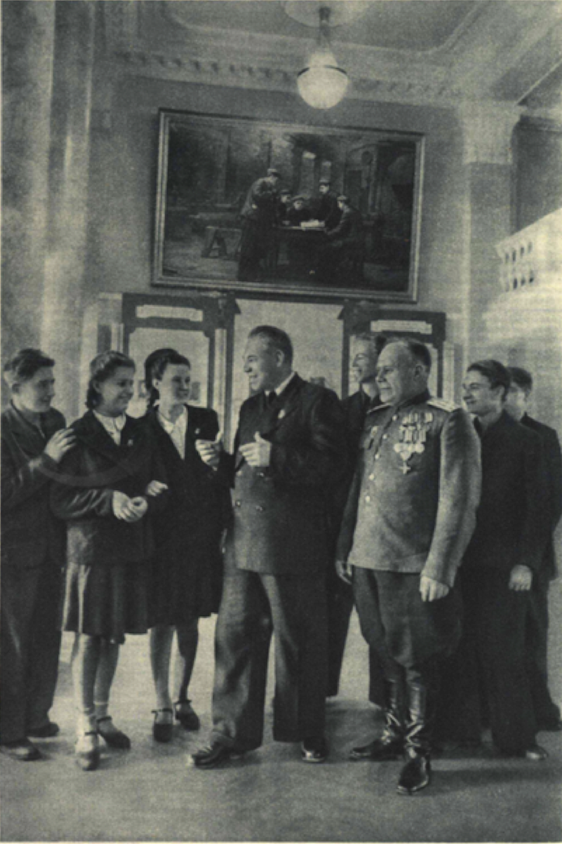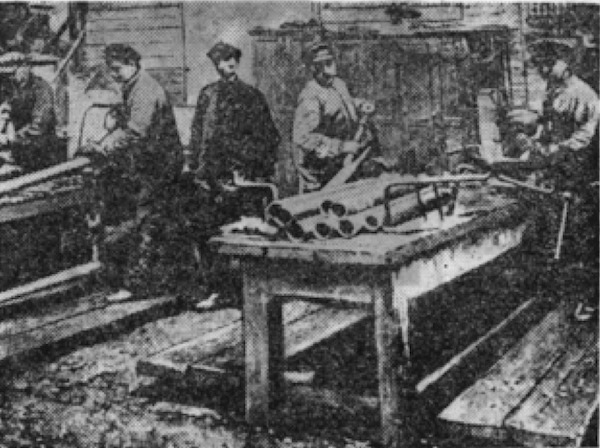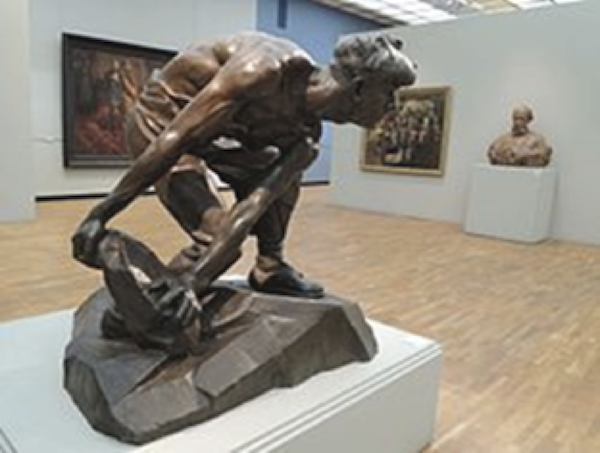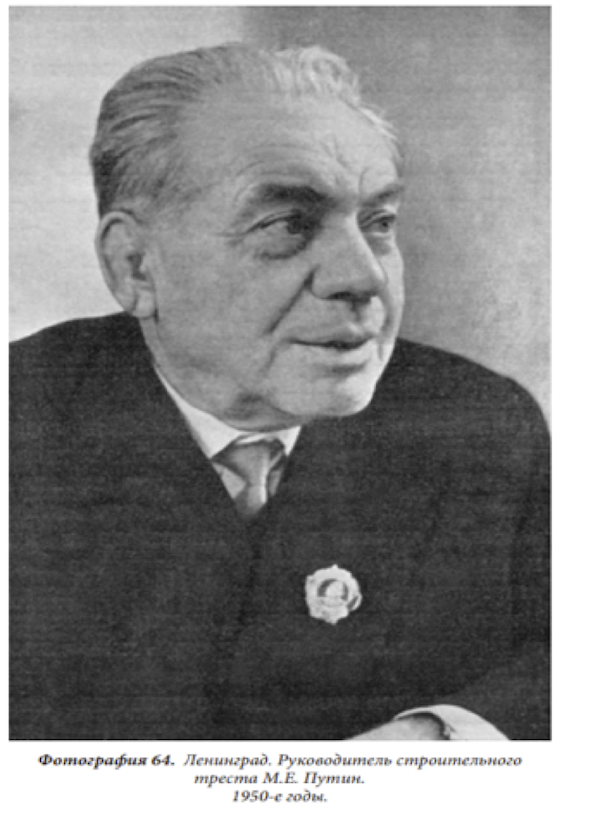What's Hiding in Putin's Family History?

In 1949, Mikhail Putin visits a worker club at the Red Vyborzhets factory in Leningrad with his former coworker (in uniform) Boris Kruglov. Above is a famous painting of Putin signing the first contract [dogovor] for socialist competition in 1929.
“Who is Mr. Putin?” This question, first posed in 1999, remains unanswered. Married? Children? Even basic information on Russia’s president is a state secret. Kremlin propaganda trumpets Vladimir’s humble origins, but offers meager details. For example, on October 27, 2022, Putin claimed his working class background allowed him to “delicately feel the pulse of common people.”
I question this legend by asserting that Putin benefited from a familial connection to a prominent member of the Soviet elite, Mikhail Eliseevich Putin (1894–1969). Mikhail helped establish “socialist competition,” a crucial institution for Stalinist modernization whereby workers were encouraged to contend for social recognition instead of wages. Once a “name familiar to all Soviets,” Mikhail Putin is a forgotten figure, and this is no coincidence.
The nineteenth-century thinker Marquis de Coustine held that Russia was a nation that strives to forget. George Orwell used the imagery of “memory holes” to describe Stalinist history. For Hannah Arendt, “the only rule of which everybody in a totalitarian state may be sure is that the more visible government agencies are, the less power they carry, and the less is known of the existence of an institution, the more powerful it will ultimately turn out to be.” Thus Russian constitutions and political parties are facades: real power resides, in the ruling families. Dynastic bloodlines are studiously concealed from public scrutiny.
Vladimir Putin, who now fights a war to prevent what he calls a “rewriting of history,” pathologically fears any examination into his own family. Since he became president, even the blandest of biographies have to be cleared by Kremlin handlers. Aleksey Navalny sits in prison over his “rude” investigations into Putin’s love life. In a 2020 interview, the journalist Andrei Kolesnikov, a main source for Putinology, could not say whether Putin had re-married: “I honestly don’t know, and it’s better not to know.” In Orwellian fashion, all the parish registers down to the sixteenth-century that mention Putin are off limits to researchers. Clearly, much is being hidden.
One taboo topic is Mikhail Putin. I have pieced together his biography from archival sources, interviews, Soviet newspapers and books. Apart from the reluctance of Russians to discuss this man on record, my investigation was made difficult because of Soviet falsifications in which Mikhail willingly participated. While Stalinist propaganda depicted Mikhail Putin as a vanguard Leninist, he was in reality a son of rural Russia.
Mikhail Putin: from Wrestling to Socialist Competition
According to Aleksandr Putin, the sole family chronicler and the President’s cousin, the Putins form a tight-knit clan [rod] who today number around 3000. All hail from Tver, a rural province that lies between Moscow and St. Petersburg. The Putins were serfs who were tied to patrimony-estates [votchinas]. A family legend holds that a smallpox outbreak in 1771 wiped out all the Putin line except a 13-year-old, Alesha. By end of the nineteenth century, the small Putin clan remained centered in a lightly populated region of Tver. The parish records for the local Pokrovskyaya church record a mere 148 births for the year 1910. The Tver villages inhabited by the Putin clan were small communities where everyone knew one another.
The Putin men, starting with Ivan Petrovich (1845–1918), the President’s paternal great-grandfather, were migrant workers who established a family-association (Artel) that supplied workers for restaurants in St. Petersburg. Establishing connections in the city, Ivan was followed by Spiridon, the President’s grandfather, and Mikhail Eliseevich, respectively. Mikhail’s father was a switchman for the Nikolaivskii Railroad at the Bezhetsk Station in Tver, about 140 km from the Putin homeland, Pominovo. With nine siblings, Misha, born on November 8, 1894, started work at age nine helping his father. Along the way, Misha received a few years of elementary education, presumably at the local Aleksando-Mariinskaya Church which had a total of 14 students. At twelve, Mikhail began traveling to St. Petersburg, lodging with Vladimir’s grandfather, Spiridon, on Gorokhovo Street. Born in Pominovo, Tver, at age sixteen, Spiridon apprenticed under a relative as a cook at the swanky Astoria. Thanks to Spiridon, Misha became a bus-boy at the near-by cafe of Jean Cubat.
As a teenager, the muscular Mikhail lugged cargo for a longshoreman artel in the rough-and-tumble beer manufacturing docks. During breaks, he would wrestle peasant-style (bor’ba na opoiaskakh). Local sportsmen noticed Putin and invited him to work out at Sanitas, a gym precursor. Frequented by the great wrestlers of the era, Sanitas employed scientific methods developed by physiologist Peter Lesgaft, who wrote: “mental and physical activities should be in complete harmony, for only then is it possible to fully attain self-awareness.” Successful wrestlers gained fame doing tricks in the circus for semi-literate workers. Mikhail Putin, a middleweight, never reached Olympian heights, but fought some of the famous wrestlers of the era. The lads at the docks began calling Putin “Mishka the Wrestler.”
During the Civil War, as trade froze up, the dock artel organized show matches. In Tomsk, the workers wanted to see who could last the longest against the legendary Ivan Piddubny. Putin, out of fear, retreated. Piddubny, smiling, pulled him aside and told him: “Why are you chickening out? [Chto tikaish’?] Scary, yes, but fight!”[1] Putin took his advice to heart and lasted seven minutes in the ring against this Samson.

Mikhail Putin (second from left) with his brigade at Red Vyborzhets in 1929. [Nedeli, nom 10, 1980 p.8]
Mikhail Putin’s training was interrupted by war: he served in the Red Army from May 1920 to May 1922. In 1923, Mikhail Putin became a furnace stoker at a war-ravaged Leningrad factory, Red Vyborzhets. This factory, capable of producing a multitude of products at short notice, was crucial not only for industrialization, but also for the state propaganda. Notably, vanguard-workers forged the Lenin statue at the Finland Station.
The Bolsheviks soon faced the grim reality of a Marxist revolution in a peasant land of drunkenness and illiteracy. Putin, a “half-proletarian,” became quickly valued by Party bosses. Working the furnace, Putin drank 40 cups of water per shift to endure the heat. Between shifts, hearty Mikhail organized wrestling matches, thus gaining authority (avtoritet) among his illiterate mates. Impressed, the factory Party supervisor made him an agitator.
The Bolshevik conundrum was how to transform rowdy peasants into proletarians. What was needed was a way to present factory life in a fun, theatrical light. In Stalinist fashion, the solution would be found by supposedly turning back to Lenin. According to Lenin’s essay “How to Organize Competition” workers must initiate a ruthless terror. The bourgeoisie were “parasites” who “must be dealt with mercilessly.” Stalin had “How to Organize Competition” published in Pravda in 1929 to justify forced industrialization. Lenin in his pamphlet suggested the Bolsheviks experiment with different methods to motivate the “half-proletarians.”
Although Putin’s effort was one out of many, Red Vyborzhets was canonized to become the template for industrialization. According to legend, later taught to every Soviet schoolchild, Putin read Lenin’s work to his brigade. “So great was the impression of Lenin’s simple words that everyone was lost in thought.” The workers exclaimed: “How can Leninist thoughts be realized?” There was a heated dispute, but Putin remembered the advice of Piddubny: “Don’t chicken out!”
Putin suggested: “Let’s write a contract! We will compete with each other, and challenge our fellows.”
“And win a prize?” A fellow worker, Kruglov, simplistically exclaimed.
“It’s not who wins,” Putin objected, “this is not our principle. But to finish the job faster, better.” Putin found a student notebook and drew up the first contract of socialist competition on March 15, 1929.
In reality, this worker initiative was staged-managed from above. The Party sent skilled propagandists to Vyborzhezs to concoct a story. At first, 186 workers, under strict supervision, were to “compete.” The Party bosses asked skilled machine operators to formalize their obligations in a written contract, but they refused. By April, the Party had browbeaten several brigades to sign contracts. Putin’s brigade was the only one that agreed to wage reductions. They signed, not in March, but on 13 May.
Stalin soon proclaimed, “competition is a communist method of building socialism based on the maximum activity of millions of workers.” Indeed, this “grass-roots initiative” was a Stalinist masterstroke: Actual proletarians, professionals, who realized that “socialist competition” was preposterous and counter-productive, were marginalized. To boot, many of these seasoned workers were Trotskyites. Young provincials, such as Putin, would be elevated through “competition” while owing their allegiance to Stalin. Thus, Stalin forged a pivotal political base.
Socialist competition fostered a carnival atmosphere that focused on social recognition rather than economics. A key to acclimatizing peasants to factory life, competition spread thought the socialist world, and is still prominent in North Korea. The name “Putin” entered the Ukrainian discourse thanks to “sotsialistychne zmahannia.”

Mikhail Putin was the model for Ivan Shadr’s sculpture "Cobblestone - the Weapon of the Proletariat" (1927)
While not the “initiator” of competition, Mikhail Putin was no mere cog in the machine. The athletic Putin embodied the Bolshevik ideal of the “new” worker. A shirtless Putin served as the model for the I.D. Shadr sculpture “Cobblestone: Weapon of the Proletariat,” a 1927 glorification of macho proletarians. Sergei Kirov, who voiced worries about the influx of unruly peasants to the factories, would have found Putin an invaluable enforcer. Mikhail Putin received visits from Kirov who was instrumental in propagating socialist competition.
After “initiating” socialist competition, Putin was soon entrusted with another sensitive mission, agitating for collectivization. In fall 1930, Putin’s brigade left for a village, Nizhnee Chuevo, in Tambov. Putin went to the houses of the poorest peasants to explain the benefits of collectivization. In true Putin style, Mikhail embellished his tale by recounting how he was attacked by three wolfhounds unleashed by the kulaks.
Mikhail Putin was well compensated for his services. In 1931, he was awarded the Soviets’ highest honor, the Order of Lenin. Graduating from the School of Trade Unions in 1933, he managed a Leningrad construction trust. Moving into an elite apartment, dubbed “fairy tale,” next to the Kirov Theater, Mikhail married a beautiful young woman, 16 years his junior. During a pivotal (and still enigmatic) moment in Soviet history, Putin in 1934 chaired Sergei Kirov’s funeral. This, no doubt, endowed him with a powerful aura.
During the war, Mikhail Putin heroically supervised construction projects in Leningrad, often close to the front lines. Even during wartime, Mikhail returned to his factory, Vyborzhets, to celebrate militarized anniversaries of Socialist Competition.
After World War II, Mikhail Putin became a trusted elder. In Pravda he was lionized along with the miner Alexei Stakhanov. While Stakhanov’s debauchery so angered the Party that he was stripped of his Moscow furnishings and quietly retuned to the Donbass, Putin, living “a humble life,” continued agitating up to age 75. Unlike other labor heroes, Putin was consulted by scholars. A typical propaganda piece relates: “Time passed and the labor veterans aged, but they never forget their factories. A gray-haired man with the Order of Lenin on his chest often visited Vyborzhets: Putin. The shop was changing before his eyes: no cramped, dark cells anymore. Powerful, high-performance tube mills stand along the wide, bright aisles: Putin’s profession has disappeared.” Putin became known for his impassioned talks.

Mikhail Putin, a Leningrad Construction Boss (with the Order of Lenin)
Putin thus became a valuable tool for indoctrination. “The participation of the veterans of the Revolution and labor […] is extremely important in educating working youth on revolutionary and labor traditions.” University students would be bused to Vyborzhets and “introduced to the latest equipment” and sometimes Putin himself. On November 25, 1958, on the eve of the 21st Party Congress at the storied Tauride Palace, 1,500 people gathered for a meeting broadcast by radio that showcased Putin. In encyclopedias, “Putin” appeared next to Alexander Pushkin. A “1929” installment of the Soviet TV program Our Biography (1978) and a film Spring of Labor (1975) focused on Mikhail.
MIKHAIL AND VLADIMIR
During the famine years of the 30s, as a way for Mikhail Putin to return a favor, Spiridon (the President’s grandfather) was set up in Moscow at the Gorki Palace to cook for Party bosses, including Stalin.[1] Instead of moving in with Spiridon, the President’s father Vladimir and his wife Maria left Tver for Leningrad, presumably because of Mikhail. During the blockade, Putin’s mother, according to the President, “lived with a relative on the embankment of the Fontanka River.” This, assuredly, would be with Mikhail Putin. In 1942, his apartment at the Skazka House was destroyed by bombing so that Mikhail moved to a nearby apartment, at 109 Fontanka St. Off and on, Vladimir’s family continued living with “relatives” until Vladimir landed a good job at the Egorov factory and they were given an apartment on Baskov Lane. (In “yet another coincidence, to which we have become accustomed,” Russian state-controlled media reported in 2004 that Mikhail Putin’s grandson, Viktor, was living on Baskov Lane.) We know that relatives of Mikhail’s wife became well acquainted with both the President’s father and grandfather. Vladimir talked little with his father, who was scarred by the war. But he used to visit a “relative”—perhaps Mikhail?—who recounted family history (by 1995, around one hundred Putins lived in St Petersburg, but from 1930 to 1970, there were only two or three Putin households in the city).
While nepotism was officially discouraged, the Soviets did promote “worker dynasties.” Propaganda articles highlighted the “wonderful” Vyborzhets families. Mikhail Putin was regarded as a paterfamilias of the “school of communist labor.” At Vyborzhets, according to Soviet propaganda, family dynasties enjoyed the “authority and deep respect of the collective. The display of such glorious labour traditions of hereditary working families in lecture and propaganda work is important in educating young people and instilling in them a love of work.” Mikhail’s efforts to guide struggling Vladimir would thus have received official blessing. Under the radar, nepotism became entrenched in the Party ranks as seen with Leonid Brezhnev’s own daughter, Galina.
Inter-generational sports was also a part of Soviet indoctrination. Mikhail “kept in touch with his native factory,” helping to build a good club and stadium. From time to time, Mikhail met his old Sanitas wrestling mate Sergei Dashkevich (1896–1953). Dashkevich took Judo courses under the legendary Vasily Oshchepkov. In order to set oneself up teaching Judo in Leningrad, it would certainly have been helpful to be connected with someone with Putin’s sway. Mikhail Putin may have been instrumental in helping Dashkevich’s pupil, Anatolii Rakhlin establish the Judo Club currently located across the street from Vyborzhets factory. In the 1960s Soviet police state, the idea of a Judo (or Sambo) club, directed by a Jew and open to the public, would have been unheard of. Tellingly, Rakhlin’s club was not in some basement but was first located in the renowned Yusupov Palace, the site of Rasputin’s murder, and a four-minute walk from Mikhail’s house. This unique club was named “Pipe-builder” (Trubostroitel’)—Mikhail’s profession.
Times had changed: in place of peasant-brawlers, cultural heroes became scientists and scholars. Vladimir was estranged from his father and adrift at school. It is reasonable to assume that he would have thrown himself at the chance to follow in the footsteps of the iconic Misha the Wrestler. Certainly, martial arts shaped Putin’s personality. This straightened out the spoiled Vladimir, but training and the 40-minute trolleybus commute left little time for study. Rakhlin, acknowledging Putin’s limited academic potential, recommended that he enter community technical college (Vtuz); at school Putin had received many Cs (troiki) which would have barred him from entering university.
Instead, Putin inexplicably got in the international division of the law faculty at Leningrad University, a notorious bastion of golden youth. Here students interacted with foreigners, read banned “petty-bourgeois” scholars, and took subjects such as “State Law in Bourgeois Countries.” All this was strictly limited to “verified” youth, and certainly not open to a nobody who was also a brawler and who fraternized with Jews, at a time when the 1967 Arab-Israeli War had caused a wave of anti-Semitism. Clearly, Putin’s entrance required connections (blat). It must have been Mikhail Putin who pulled the strings. Mikhail, old Leningraders whisper, wrote the required recommendation letter for Putin to enter the KGB.[1] Mikhail Putin, who died in 1969, was lionized in the front pages of Pravda: few would question the last wishes of this legendary man. According to Dmitrii Gantserov, a recruiter working in the 3rd department of the 5th Chief Directorate of the KGB, Putin inexplicably, from his freshman year, was considered a prime candidate out of an already elite group of law faculty students. The Leningrad KGB headquarters gave a green light to Putin’s candidacy based on a review of family relations (proverka dal’nikh rodstvennikov). For the final acceptance, during Putin’s last year of study in 1974, Gantserov was ordered to make a thorough review of Putin’s family background by personally interviewing family members (without naming himself, Vladimir Putin himself has admitted that connections (blat) are what made a KGB career in those days). The shadow of Mikhail would continue to give Putin a leg up. Key members of the Putin elite such as Valentina Matvienko would have heard Grigorii Romanov, the first secretary in Leningrad, herald Mikhail Putin as a hero who “our whole country follows today.”
As is the case for the majority of post-socialist societies, the leader’s princeling status is essential for acting as guardian and arbitrator over the ruling dynasties. This is what drove Putin’s rise to power. Amid a reactionary backlash, Putin protected the legacy of his former boss, the Mayor of St. Petersburg, Anatoli Sobchak, as well the business and political interests of his wife, Liudmila Narusova, and daughter Kseniia. Based on this reputation, Valentin Yumashev, Tat’iana Yeltsin, and other members of Boris Yeltsin’s family urged the president to select Putin as successor in 1999.
As with the President’s appearance and gait, Vladimir’s career closely hews to Mikhail’s: from macho wrestler, to wily political insider, to Party sage. The model of socialist competition—the notion that political theatre can replace trade-union politics and market forces—epitomizes Putin’s authoritarianism. Facing turmoil in his war with Ukraine, Vladimir Putin continues to turn to the people he trusts, his Leningrad Judo partners and their children.
[1] In 2022, Putin named as his mentors: two school teachers, Tamara Chizhova and Vera Gurevich, and his trainer Anatoli Rakhlin. None of these would be able to provide a recommendation authoritative enough to get into the KGB.
[1] In paranoid Russian society, the leader’s cook is no humble job. Putin’s chef, Yevgeny Prigozhin, is a critical member of the elite.
[1] In strikingly similar language, Vladimir Putin often tells school children that his mentor, Anatoly Rakhlin, urged him to “fight to the end.”